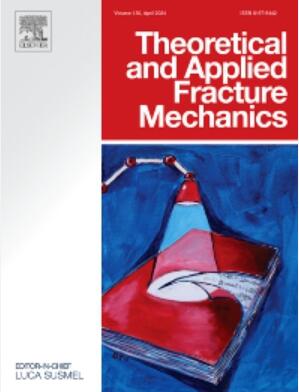花岗岩岩石热诱发预存微裂缝及其对断裂行为影响的统计分析
IF 5
2区 工程技术
Q1 ENGINEERING, MECHANICAL
引用次数: 0
摘要
含有不同程度微裂缝的岩石对其机械行为有重大影响。了解预先存在的微裂缝(PEMs)对岩石断裂机制的影响在地热能源、核废料处理和深部采矿等领域具有科学和实用价值。我们采用热诱导的方法在花岗岩岩石中产生了微裂缝,并通过可视化方法量化了微裂缝的特征参数,重点研究了微裂缝与岩石机械强度和声发射(AE)特性之间的定量关系。我们发现热诱导 PEMs 的分布特征服从对数正态分布,且单个热诱导 PEMs 的长度几乎与温度无关。PEM 的密度和方向共同决定了纵波速度和岩石强度的变化,其中微裂缝密度的影响占主导地位。AE 信号表明,PEMs 会影响断裂行为和断裂机制,这取决于预先存在的微裂缝和应力诱发的微裂缝的相对优势。AF-RA 值表明,PEMs 会导致岩石断裂机制发生重大转变。当微裂缝密度较低时,拉伸模式在岩石破坏中占主导地位。反之,岩石断裂则以剪切机制为主。本文章由计算机程序翻译,如有差异,请以英文原文为准。
Statistical analysis of thermally induced pre-existing microcracks and their influence on fracture behaviours of granite rock
Rocks containing varying degrees of microcracks have a significant influence on their mechanical behavior. Understanding the effect of pre-existing microcracks (PEMs) on rock fracture mechanisms has scientific and practical value in areas such as geothermal energy, nuclear waste disposal and deep mining. We employed a thermally induced approach to create PEMs in granite rock, and quantified characteristic parameters of PEMs by visualization methods, focusing on the quantitative relationships between the PEMs and the mechanical strength and acoustic emission (AE) properties of the rock. We find that the distribution characteristics of thermally induced PEMs obey a lognormal distribution, and the length of individual thermally induced PEMs is almost independent of temperature. The density and orientation of PEMs together determine the variation of the longitudinal wave velocity and rock strength, with the effect of microcrack density dominating. The AE signal suggests that PEMs can affect the fracture behavior and fracture mechanism, depending on the relative dominance of pre-existing and stress-induced microcracks. The AF-RA values show that PEMs lead to an important shift in the fracture mechanism of the rock. When the microcrack density is low, tensile mode dominates the rock failure. Conversely, the shear mechanism dominates the rock fracture.
求助全文
通过发布文献求助,成功后即可免费获取论文全文。
去求助
来源期刊

Theoretical and Applied Fracture Mechanics
工程技术-工程:机械
CiteScore
8.40
自引率
18.90%
发文量
435
审稿时长
37 days
期刊介绍:
Theoretical and Applied Fracture Mechanics'' aims & scopes have been re-designed to cover both the theoretical, applied, and numerical aspects associated with those cracking related phenomena taking place, at a micro-, meso-, and macroscopic level, in materials/components/structures of any kind.
The journal aims to cover the cracking/mechanical behaviour of materials/components/structures in those situations involving both time-independent and time-dependent system of external forces/moments (such as, for instance, quasi-static, impulsive, impact, blasting, creep, contact, and fatigue loading). Since, under the above circumstances, the mechanical behaviour of cracked materials/components/structures is also affected by the environmental conditions, the journal would consider also those theoretical/experimental research works investigating the effect of external variables such as, for instance, the effect of corrosive environments as well as of high/low-temperature.
 求助内容:
求助内容: 应助结果提醒方式:
应助结果提醒方式:


